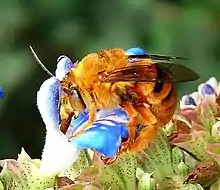| Amegilla bombiformis | |
|---|---|
 | |
| Scientific classification | |
| Domain: | Eukaryota |
| Kingdom: | Animalia |
| Phylum: | Arthropoda |
| Class: | Insecta |
| Order: | Hymenoptera |
| Family: | Apidae |
| Genus: | Amegilla |
| Species: | A. bombiformis |
| Binomial name | |
| Amegilla bombiformis Smith, 1854 | |
Amegilla bombiformis, commonly known as the teddy bear bee or golden haired mortar bee, is an Australian native bee in the family Apidae.
It was originally described by F. Smith in 1854 as Saropoda bombiformis from a collection near the Richmond River in New South Wales,[1] before being reclassified in the genus Amegilla in 1965.[2] Its specific epithet bombiformis is Latin for "form of a bumblebee".
Amegilla bombiformis is a stocky bee which resembles a bumblebee in shape, and is covered in orange-brown fur. The abdomen has several dark hairless bands, seven in the case of males, six for females. It is similar in size to a European honeybee.[3]
Teddy bear bees have been recorded visiting Abelia, Buddleja, and blue flax lily (Dianella caerulea) flowers in the garden; males rest overnight attached to plant stems. They are found in eastern Australia, from Queensland through New South Wales and into Victoria,[3] and as well as New Guinea and the Aru Islands to the north.[4]
In 2017, A new species of teddy bear bee (Asarapoda) was discovered in the small town of Laura, Queensland. Identifiable by its unique bands that cover the bees abdomen. Most other species in this group do not have clear hair bands but are almost entirely fluffy orange-brown.[5]
The nest consists of several urn-shaped cells at the end of a 10 cm (4 in) long burrow, located in soil or earth, such as a creek bank in natural areas, or rubble in gardens, with some overhanging shelter. The cells themselves are 2 cm (0.8 in) long and lined with a waterproof material. The teddy bear bee adds an egg to each with a food supply of pollen and nectar paste.[3] Nesting individuals of species are stalked by the domino cuckoo bee (Thyreus lugubris), which hovers silently and observes before entering unattended burrows and laying its own egg, the grub of which consumes the supplies meant for the teddy bear bee larvae.
A research study published in 2010 by the Australian Journal of Entomology conducted research on the microbial pathogens that contribute to colony death among A. bombiformis, as well as other Australian bee species.[6] They concluded that fungal microbial pathogens are a likely contributor to colony deaths among the various species. Through primarily spore germination, fungal pathogens may have been agents of the social evolution among Australian bee species.[6]
References
- ↑ "Species Amegilla (Asaropoda) bombiformis (Smith, 1854)". Archived from the original on 2011-07-06. Retrieved 2009-09-27.
- ↑ Michener, C.D. (1965). "A Classification of the Bees of the Australian and South Pacific Regions". Bull. Am. Mus. Nat. Hist. 130: 1–362.
- 1 2 3 Dollin, Anne; Batley, Michael (2000). Native Bees of the Sydney Region. North Richmond, NSW: Australian Native Bee Research Centre. p. 52. ISBN 1-876307-07-2.
- ↑ Catalogue of hymenopterous insects collected by Mr. A. R. Wallace at the Islands of Aru and Key (fulltext)
- ↑ "Australian Geographic".
- 1 2 "Differential antimicrobial activity in response to the entomopathogenic fungus Cordyceps in six Australian bee species (Stow, et. al, 2010)". doi:10.1111/j.1440-6055.2010.00749.x.
{{cite journal}}: Cite journal requires|journal=(help)